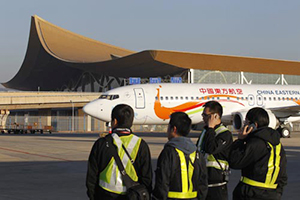"This new route will help the regional economy, boost tourism and provide a convenient connection for tens of thousands of visitors.''
Early last year, Air China, the country's largest airline, was the first Chinese carrier to run direct flights to Geneva from Beijing. It also launched a new Chengdu-Frankfurt service.
As the UK market becomes increasingly important, China Southern Airlines opened its Guangzhou-London route in June 2012, at the time operating three flights a week. This later increased to five flights a week and, in September, started to operate with its new Boeing 787 aircraft.
While domestic travel figures continue to rise, price wars among airlines and the roll-out of the country's high-speed rail network mean companies operate on thin profits to stay competitive.
Furthering competition, the Chinese government has gradually eased regulations on the aviation industry, lifting a six-year ban on the establishment of independent air carriers and giving the green light to two new privately owned airlines.
But even as they seek greener pastures, their relatively late entry into the international travel arena has made it an uphill battle for Chinese airlines, says Andrew Herdman, director-general of the Association of Asia-Pacific Airlines.
"Chinese airlines do face competitive disadvantages when they go international — in terms of product, perception, brand awareness, distribution, capability and so on," he says.
"With the growth of incomes in China and the fact that we now have a lot of outbound travel, that plays to the strength of the Chinese airlines because they are brands that are well known to Chinese travelers.
"But historically, long-haul flights to China were inbound-focused and the market source was the EU and America, so the Chinese airlines have had a disadvantage in terms of brand awareness and distribution presence in those source markets."
The increasingly refined tastes of travelers from the Chinese mainland also add to the potential success of new long-haul routes operated by China's airlines.
While global alliance partnerships have ensured that the airlines operate to international standards, most well-to-do Chinese vacationers still opt to go with international brands because they are perceived as more luxurious, says Herdman.
"Sophisticated mainland customers are quite savvy about which brands they choose, as you can tell by the kind of cars they buy and the type of luxury goods they buy," he says.
"When it comes to which hotels they stay in and which airlines they favor, they are well aware they have a choice.
"It puts pressure on the mainland carriers to up their game in terms of product and service internationally."
Regardless of factors at play, enterprising mainland airlines are making headway in the US.
According to a survey by PricewaterhouseCoopers, US airlines last year operated 53 percent of the routes between the US and China, a drop of nearly 7 percent from the year before.
Chinese airlines were responsible for the remaining 47 percent.
Don't miss
|
 |
Navigating a new growth course
 |